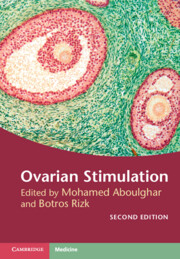Book contents
- Ovarian Stimulation
- Ovarian Stimulation
- Copyright page
- Dedication
- Contents
- Contributors
- About the Editors
- Foreword
- Preface to the first edition
- Preface to the second edition
- Section 1 Mild Forms of Ovarian Stimulation
- Section 2 Ovarian Hyperstimulation for IVF
- Section 3 Difficulties and Complications of Ovarian Stimulation and Implantation
- Section 4 Non-conventional Forms Used during Ovarian Stimulation
- Chapter 20 Adjuncts for Ovarian Stimulation
- Chapter 21 Luteinizing Hormone Supplementation during Ovarian Stimulation
- Chapter 22 Ovulation Induction for Hypogonadotropic Hypogonadism
- Section 5 Alternatives to Ovarian Hyperstimulation and Delayed Transfer
- Section 6 Procedures before, during, and after Ovarian Stimulation
- Index
- References
Chapter 20 - Adjuncts for Ovarian Stimulation
from Section 4 - Non-conventional Forms Used during Ovarian Stimulation
Published online by Cambridge University Press: 14 April 2022
- Ovarian Stimulation
- Ovarian Stimulation
- Copyright page
- Dedication
- Contents
- Contributors
- About the Editors
- Foreword
- Preface to the first edition
- Preface to the second edition
- Section 1 Mild Forms of Ovarian Stimulation
- Section 2 Ovarian Hyperstimulation for IVF
- Section 3 Difficulties and Complications of Ovarian Stimulation and Implantation
- Section 4 Non-conventional Forms Used during Ovarian Stimulation
- Chapter 20 Adjuncts for Ovarian Stimulation
- Chapter 21 Luteinizing Hormone Supplementation during Ovarian Stimulation
- Chapter 22 Ovulation Induction for Hypogonadotropic Hypogonadism
- Section 5 Alternatives to Ovarian Hyperstimulation and Delayed Transfer
- Section 6 Procedures before, during, and after Ovarian Stimulation
- Index
- References
Summary
Clomiphene (clomifene) citrate (CC) and follicle-stimulating hormone (FSH) have traditionally been considered the two main modalities used for ovarian stimulation (OS). However, many adjuncts have been used to maximize the convenience and effectiveness of these two agents, often specifically targeted to subsets of women undergoing stimulation. Most of these adjuncts are not officially approved for these indications. Therefore, educators and practitioners must take it upon themselves to assess the evidence supporting their use, and make treatment recommendations and decisions accordingly. We have outlined in an editorial in Fertility and Sterility a process to aid in this endeavor [1]. Decisions are based not only on randomized clinical trials (RCT), but also on other basic science and clinical evidence supporting their use.
- Type
- Chapter
- Information
- Ovarian Stimulation , pp. 189 - 198Publisher: Cambridge University PressPrint publication year: 2022



